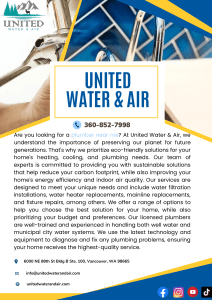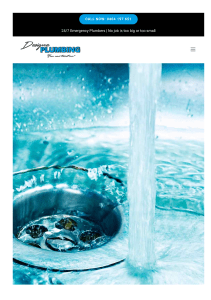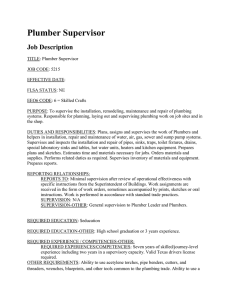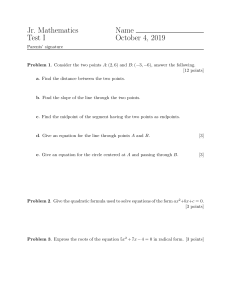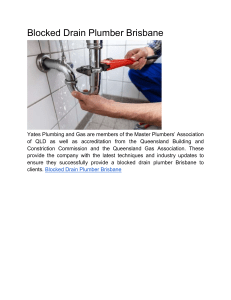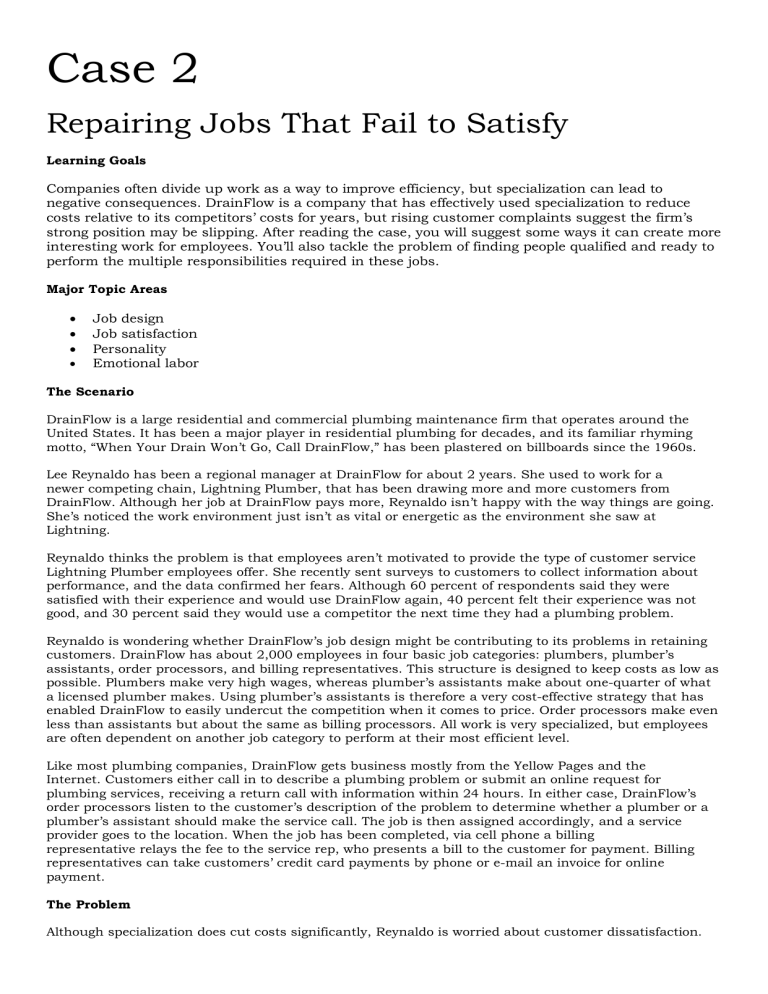
Case 2 Repairing Jobs That Fail to Satisfy Learning Goals Companies often divide up work as a way to improve efficiency, but specialization can lead to negative consequences. DrainFlow is a company that has effectively used specialization to reduce costs relative to its competitors’ costs for years, but rising customer complaints suggest the firm’s strong position may be slipping. After reading the case, you will suggest some ways it can create more interesting work for employees. You’ll also tackle the problem of finding people qualified and ready to perform the multiple responsibilities required in these jobs. Major Topic Areas Job design Job satisfaction Personality Emotional labor The Scenario DrainFlow is a large residential and commercial plumbing maintenance firm that operates around the United States. It has been a major player in residential plumbing for decades, and its familiar rhyming motto, “When Your Drain Won’t Go, Call DrainFlow,” has been plastered on billboards since the 1960s. Lee Reynaldo has been a regional manager at DrainFlow for about 2 years. She used to work for a newer competing chain, Lightning Plumber, that has been drawing more and more customers from DrainFlow. Although her job at DrainFlow pays more, Reynaldo isn’t happy with the way things are going. She’s noticed the work environment just isn’t as vital or energetic as the environment she saw at Lightning. Reynaldo thinks the problem is that employees aren’t motivated to provide the type of customer service Lightning Plumber employees offer. She recently sent surveys to customers to collect information about performance, and the data confirmed her fears. Although 60 percent of respondents said they were satisfied with their experience and would use DrainFlow again, 40 percent felt their experience was not good, and 30 percent said they would use a competitor the next time they had a plumbing problem. Reynaldo is wondering whether DrainFlow’s job design might be contributing to its problems in retaining customers. DrainFlow has about 2,000 employees in four basic job categories: plumbers, plumber’s assistants, order processors, and billing representatives. This structure is designed to keep costs as low as possible. Plumbers make very high wages, whereas plumber’s assistants make about one-quarter of what a licensed plumber makes. Using plumber’s assistants is therefore a very cost-effective strategy that has enabled DrainFlow to easily undercut the competition when it comes to price. Order processors make even less than assistants but about the same as billing processors. All work is very specialized, but employees are often dependent on another job category to perform at their most efficient level. Like most plumbing companies, DrainFlow gets business mostly from the Yellow Pages and the Internet. Customers either call in to describe a plumbing problem or submit an online request for plumbing services, receiving a return call with information within 24 hours. In either case, DrainFlow’s order processors listen to the customer’s description of the problem to determine whether a plumber or a plumber’s assistant should make the service call. The job is then assigned accordingly, and a service provider goes to the location. When the job has been completed, via cell phone a billing representative relays the fee to the service rep, who presents a bill to the customer for payment. Billing representatives can take customers’ credit card payments by phone or e-mail an invoice for online payment. The Problem Although specialization does cut costs significantly, Reynaldo is worried about customer dissatisfaction. According to her survey, about 25 percent of customer contacts ended in no service call because customers were confused by the diagnostic questions the order processors asked and because the order processors did not have sufficient knowledge or skill to explain the situation. That means fully one in four people who call DrainFlow to hire a plumber are worse than dissatisfied: they aren’t customers at all! The remaining 75 percent of calls that did end in a customer service encounter resulted in other problems. The most frequent complaints Reynaldo found in the customer surveys were about response time and cost, especially when the wrong person was sent to a job. A plumber’s assistant cannot complete a more technically complicated job. The appointment has to be rescheduled, and the customer’s time and the staff’s time have been wasted. The resulting delay often caused customers in these situations to decline further contact with DrainFlow—many of them decided to go with Lightning Plumber. “When I arrive at a job I can’t take care of,” says plumber’s assistant Jim Larson, “the customer gets ticked off. They thought they were getting a licensed plumber, since they were calling for a plumber. Telling them they have to have someone else come out doesn’t go over well.” On the other hand, when a plumber responds to a job easily handled by a plumber’s assistant, the customer is still charged at the plumber’s higher pay rate. Licensed plumber Luis Berger also does not like being in the position of giving customers bad news. “If I get called out to do something like snake a drain, the customer isn’t expecting a hefty bill. I’m caught between a rock and a hard place—I don’t set the rates or make the appointments, but I’m the one who gets it from the customer.” Plumbers also resent being sent to do such simple work. Susie McCarty is one of DrainFlow’s order processors. She’s frustrated too when the wrong person is sent to a job but feels she and the other order processors are doing the best they can. “We have a survey we’re supposed to follow with the calls to find out what the problem is and who needs to take the job,” she explains. “The customers don’t know that we have a standard form, so they think we can answer all their questions. Most of us don’t know any more about plumbing than the caller. If they don’t use the terms on the survey, we don’t understand what they’re talking about. A plumber would, but we’re not plumbers; we just take the calls.” Customer service issues also involve the billing representatives. They are the ones who have to keep contacting customers about payment. “It’s not my fault the wrong guy was sent,” says Elizabeth Monty. “If two guys went out, that’s two trips. If a plumber did the work, you pay plumber rates. Some of these customers don’t get that I didn’t take their first call, and so I get yelled at.” The billing representatives also complain that they see only the tail end of the process, so they don’t know what the original call entailed. The job is fairly impersonal, and much of the work is recording customer complaints. Remember—40 percent of customers aren’t satisfied, and it’s the billing representatives who take the brunt of their negative reactions on the phone. As you can probably tell, all employees have to engage in emotional labor, as described in your textbook, and many lack the skills or personality traits to complete the customer interaction component of their jobs. They aren’t trained to provide customer service, and they see their work mostly in technical, or mechanical, terms. Quite a few are actually anxious about speaking directly with customers. The office staff (order processors and billing representatives) realize customer service is part of their job, but they also find dealing with negative feedback from customers and coworkers taxing. A couple of years ago a management consulting company was hired to survey DrainFlow worker attitudes. The results showed they were less satisfied than workers in other comparable jobs. The following table provides a breakdown of respondent satisfaction levels across a number of categories: DrainFlow Plumbers I am satisfied with the work I am asked to do. I am satisfied with my working conditions. I am satisfied with my interactions with coworkers. I am satisfied with my interactions with my supervisor DrainFlow Office Workers 2.5 Average Plumber 3.7 DrainFlow Plumber Assistants 2.5 4.3 Average Office Worker 3.5 3.8 2.4 3.7 4.1 4.2 3.5 3.2 2.7 3.8 3.9 2.5 2.3 2.2 3.5 3.4 The information about average plumbers and average office workers is taken from the management consulting company’s records of other companies. They aren’t exactly surprising, given some of the complaints DrainFlow employees have made. Top management is worried about these results, but they haven’t been able to formulate a solution. The traditional DrainFlow culture has been focused on cost containment, and the “soft stuff” like employee satisfaction hasn’t been a major issue. The Proposed Solution The company is in trouble, and as revenues shrink and the cost savings that were supposed to be achieved by dividing up work fail to materialize, a change seems to be in order. Reynaldo is proposing using cash rewards to improve performance among employees. She thinks if employees were paid based on work outcomes, they’d work harder to satisfy customers. Because it’s not easy to measure how satisfied people are with the initial call-in, Reynaldo would like to give the order processors a small reward for every 20 calls successfully completed. For the hands-on work, she’d like to have each billing representative collect information about customer satisfaction for each completed call. If no complaints are made and the job is handled promptly, a moderate cash reward would be given to the plumber or plumber’s assistant. If the customer indicates real satisfaction with the service, a larger cash reward would be provided. Reynaldo also wants to find people who are a better fit with the company’s new goals. Current hiring procedure relies on unstructured interviews with each location’s general manager, and little consistency is found in the way these managers choose employees. Most lack training in customer service and organizational behavior. Reynaldo thinks it would be better if hiring methods were standardized across all branches in her region to help managers identify recruits who can actually succeed in the job. Your Assignment Your task is to prepare a report for Reynaldo on the potential effectiveness of her cash reward and structured interview programs. Make certain it is in the form of a professional business document that you’d actually give to an experienced manager at this level of a fairly large corporation. Reynaldo is very smart when it comes to managing finances and running a plumbing business, but she won’t necessarily know about the organizational behavior principles you’re describing. Because any new proposals must be passed through top management, you should also address their concerns about cost containment. You’ll need to make a strong evidence-based financial case that changing the management style will benefit the company. When you write, make sure you touch on the following points: CC-11. Although it’s clear employees are not especially satisfied with their work, do you think this is a reason for concern? Does research suggest satisfied workers are actually better at their jobs? Are any other behavioral outcomes associated with job satisfaction? CC-12. Using job characteristics theory, explain why the present system of job design may be contributing to employee dissatisfaction. Describe some ways you could help employees feel more satisfied with their work by redesigning their jobs. CC-13. Reynaldo has a somewhat vague idea about how to implement the cash rewards system. Describe some of the specific ways you would make the reward system work better, based on the case. CC-14. Explain the advantages and disadvantages of using financial incentives in a program of this nature. What, if any, potential problems might arise if people are given money for achieving customer satisfaction goals? What other types of incentives might be considered? CC-15.Create a specific plan to assess whether the reward system is working. What are the dependent variables that should change if the system works? How will you go about measuring success? CC-16. What types of hiring recommendations would you make to find people better suited for these jobs? Which Big Five personality traits would be useful for the customer service responsibilities and emotional labor?
